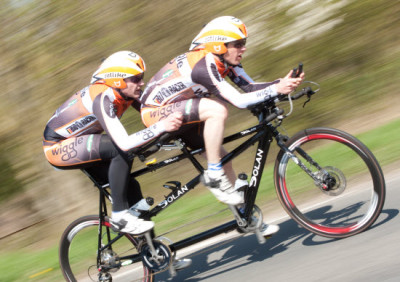Many (if not most of us) were taught some variation of; "scrape gum off the bottom of your shoe" and "try to push over the top" as the "proper" way to describe how to pedal like a "real" cyclist. But is that correct? If we really want our participants to pedal like a cyclist, is this the best way to cue proper/efficient pedaling technique?
My recently completed professional bicycle-fitting with Chris Balser the Bike Fit Guru says not necessarily.
I spent about two hours actually riding my VeloVie bicycle on a computrainer during my fitting. Not continuously and never at anything beyond a JRA level of effort. Early in the process Chris asked me; "where did you learn how to pedal?" Thinking that with way over 15,000 miles pedaling a bicycle, I've gotten to be a pretty good pedaler. So like most proud people I got defensive at his suggestion. Chris must of noticed it on my face because he quickly added; you're very smooth... but your ankle is all locked up. You are missing out on a bunch of power that's available if you'd #1) unlock your ankles and #2) focus on moving your knees through the greatest range of movement possible.
USA vs. EU pedaling techniques
To demonstrate what he was talking about he had me watch myself pedaling in a mirror from the side. My years of concentration on pushing over the top and scraping across the bottom showed Chris' observation was correct - I am smooth but my ankles were nearly locked solid with my foot at a right angle to my lower leg. That, he explained, was how people in the USA pedal.
Then he showed me a number of pictures of professional cyclists like this one of a very fast tandem team from the UK:

From http://magazine.bikeradar.com
Notice how high this captain's heel is as it crosses over the top? The idea here is that by allowing the ankle to flex and the heel to rise, you create a longer lever. Longer levers create more leverage and the force can begin earlier in the down stroke = more power. When you watch a cyclist using this technique, you'll see what Chris called "big knees" - the riders knees move in a very large plane up and down. It isn't just that their legs are long or that they're riding with long cranks. The exaggerated movement of their knees comes from the additional rage of motion allowed by the flexion of their ankles.
In this video, Joe Friel demonstrates the USA focus on "push over the top and scrap across the bottom."
Former UK professional cyclist Rebecca Ramsay runs EasyCycling.com and her video below is an excellent example of what Chris describes as the EU pedaling technique. A closeup view of this technique in slow motion begins at the 2:00 mark. Notice how much flexion she has in her ankle as it crosses the bottom. Yes she cues the "scrape across the bottom" but no push across the top. With your heel elevated there's really no way to "push" forward... just down in a strong, fluid motion that I'm learning can create some much needed, additional power from my 52 year old legs 🙂
So who's right? Good question... but I'm not sure it's the right question.
A better question would be; which way of cuing, USA or EU, will be easier to understand by our students? Or would a combination / hybrid be helpful?
I've got two assignments for you to compete and report back:
#1 - Next time you're on a bike give this a try. Concentrate on what Rebecca cues as "a flick of the ankle" at the bottom. You may feel your calf contract slightly which you'll see in the video.
#2 - Watch a stage of the Tour De France. Pay attention to the vertical movement of the rider's knees and then let us know what you find.
Originally posted 2013-07-11 14:45:12.
- Happy 75th Birthday Ed Hayes! - April 24, 2024
- Eagles pedaling through the air metaphor - April 21, 2024
- ICI Podcast 238 Meet Nerd Fitness Creator Steve Kamb - April 6, 2024

A lot of factor have to be take: body type, position on the bike, bike type and type of road profiles.
Cavendish will never turn his leg like Contador.
Riding a triathlon you search to save some muscles and the position on the bike is different. If you watch mountain bike, you use both styles.
On copper stone you do not have to move to much in your ankles, you have to PUSH PUSH and PUSH, if not you and your bike will move all around.
For me the best way to teach is: first the US way THAN the EU way; both have their advantages, each one is use in some situation, each one have it is advantages and problems ( specific pathology).